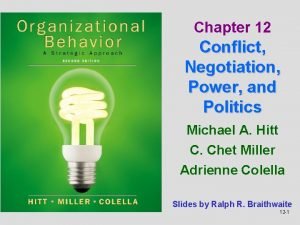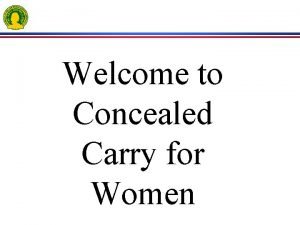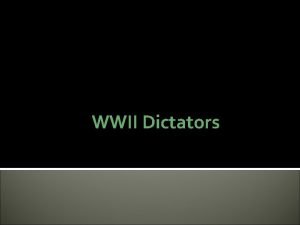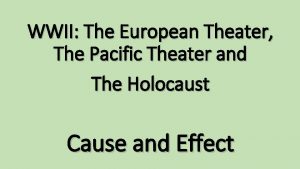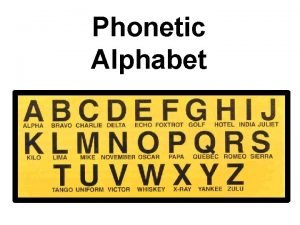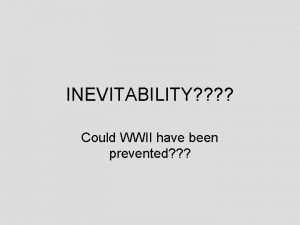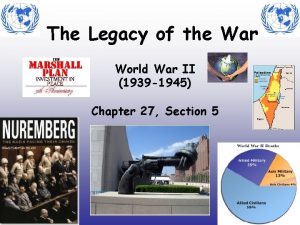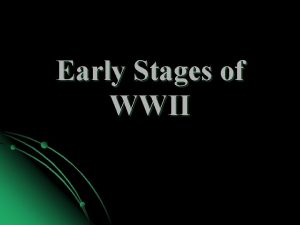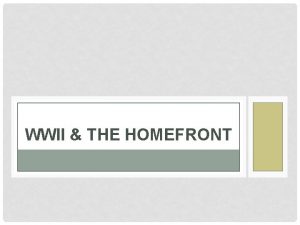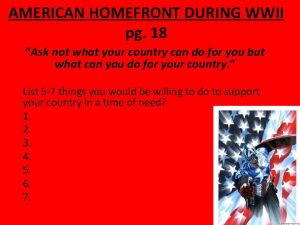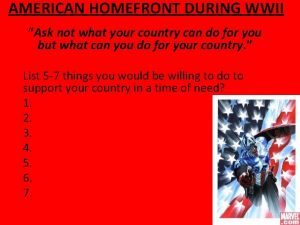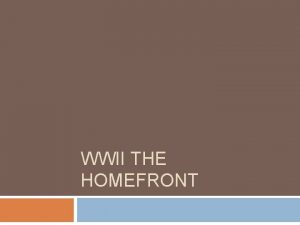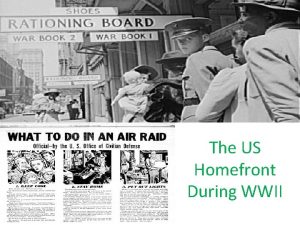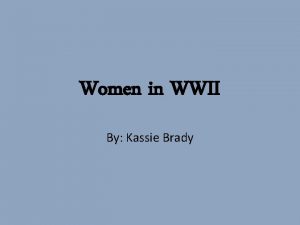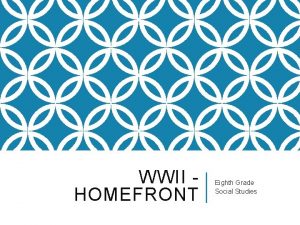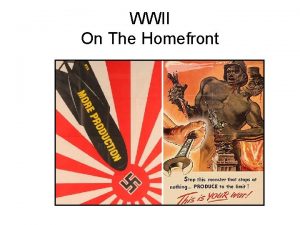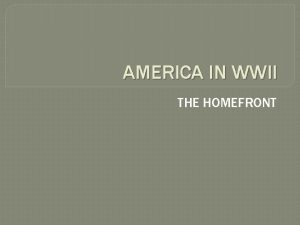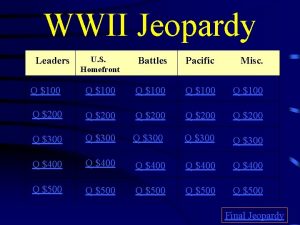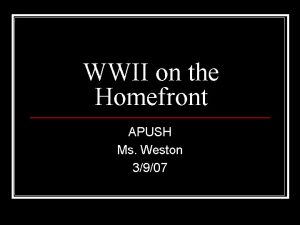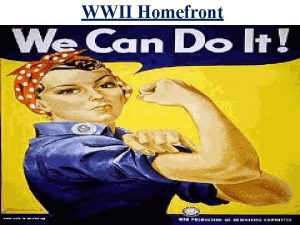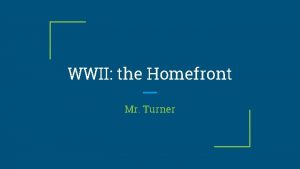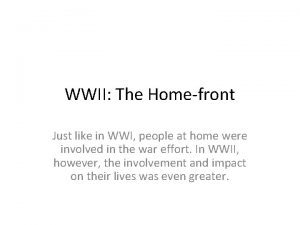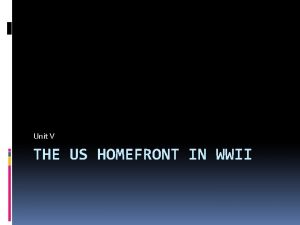The American Homefront During WWII To win wars
























- Slides: 24

The American Homefront During WWII

To win wars in Europe and the Pacific and to meet civilian demands, the U. S. government grew to its largest size ever The War Production Board directed factories to produce war supplies in order to out-produce the Axis Powers

The War Powers Act gave President Roosevelt the power to expand the government, use censorship, and limit personal liberties The U. S. gov’t spent $250 million per day from 1941 to 1945…This is 2 x as much as all previous gov’t spending combined

The government drafted soldiers and sold war bonds to raise money to fund the war War bonds helped raise $187 billion

The Office of War Information directed propaganda

Wartime production led to shortages of consumer goods and high demand for essential materials… …The Office of Price Administration set fixed prices on consumer goods and distributed ration books on essential war-related materials

Americans recycled and planted victory gardens to support the war effort

War production created new jobs, stimulated the economy, and ended the Great Depression

When the US declared war, the military needed soldiers to fight a two-front war in Europe and Asia 6 million men volunteered for the military after the Pearl Harbor attack 10 million more were drafted into service Hundreds of training camps were created, mostly in the South

During World War II, everything soldiers were given was “gov’t issue” so soldiers became known as “GIs” Judy Garland (Wizard of Oz) sang for the troops. Bob Hope did comedy routines. Homesickness among soldiers was common… …the USO brought celebrity actors, comedians, musical acts to entertain the troops

During WWII, African Americans fought in the military and at home More than 1 million Black soldiers were allowed to black soldiers served fight; The “Tuskegee Airmen” in segregated units were recognized for heroism under the command of white officers

World War II created …The Great Migration thousands of war-related continued as blacks factory jobs and moved into Northern demand for workers… cities and the west coast

African Americans faced racial discrimination in segregated units and in war-related jobs Civil rights leader A Philip Randolph threatened to “march on Washington” to force FDR to help blacks

As a result, President Roosevelt offered equal pay for black workers and created the Fair Employment Practices Commission

World War II led to opportunities for women in the workforce and military 6 million women entered the workforce in clerical work and in war-related industries

World War II led to opportunities for women in the workforce and military 6 million women entered the workforce in clerical work and in war-related industries

200, 000 women joined noncombat military units

Women served as military nurses and photographers

Due to Pearl Harbor, In 1942, President Roosevelt issued Executive Order 9066 people feared that which “relocated” 112, 000 Japanese-Americans to were spying or helping internment camps away prepare for a Japanese from the Pacific coast invasion of the USA

Americans viewed the Japanese as racially inferior and used racial stereotypes to describe the enemy as well as Japanese-Americans

The Japanese in internment camps faced poor living conditions and a lack of civil rights



Apologies for Internment • • Korematsu v. US (1944) – Supreme Court ruled that US internment violated the constitutional rights of Japanese-Americans; those imprisoned were freed Reagan signed legislation in 1988 awarding $20, 000 to each surviving Japanese-American who had been interned House Bill 442 issued an official apology Estimates are that internees suffered economic losses at least three times the total of reparations paid Fred Korematsu – claiming that his arrest violated his civil rights and liberties, he sued the US government. The case finally reached the SC, where Justice Robert Jackson was the deciding vote in favor of Korematsu
 Habit 4 think win win video
Habit 4 think win win video Win win win lose lose lose
Win win win lose lose lose Win-win win-lose lose-lose
Win-win win-lose lose-lose Advances in technology during wwii
Advances in technology during wwii Gungoddess holster
Gungoddess holster Homefront wsgc
Homefront wsgc Win win strategies
Win win strategies Think win-win scenarios
Think win-win scenarios 5 dimensions of win win
5 dimensions of win win Think win win
Think win win Win win nacin placanja
Win win nacin placanja Expand the pie
Expand the pie Example of a lose lose situation
Example of a lose lose situation Win win or no deal
Win win or no deal Win win situation examples
Win win situation examples Proxy war cold war definition
Proxy war cold war definition Wwii picture
Wwii picture 1500 dead in hawaii congress votes war
1500 dead in hawaii congress votes war Phonetic alphabet letters
Phonetic alphabet letters Could wwii have been prevented
Could wwii have been prevented Ww2 study guide answer key
Ww2 study guide answer key What caused ww2
What caused ww2 Nye commite
Nye commite Wwii test review
Wwii test review World war 2 effects
World war 2 effects

